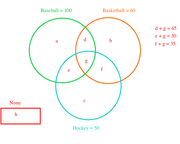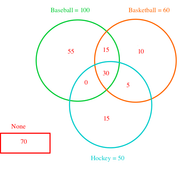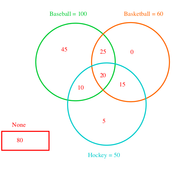Q1) A survey on a sample of 25 new cars being sold at a local dealer was conducted to see which of the three options - air conditioning, radio and power windows - were already installed. The survey found:
15 had air conditioning
2 had air conditioning and power windows but no radios
12 had radio
6 had air conditioning and radio but no power windows
11 had power windows
4 had radio and power windows
3 had all three options
What is the number of cars that had none of the options?
a) 4
b) 3
c) 1
d) 2
e) 0
___________________________________________________
Q2) There are 200 students in a school. Out of these, 100 students play baseball, 50 students play hockey, and 60 students play basketball. 30 students play both baseball and hockey, 35 students play both hockey and basketball, and 45 students play both basketball and baseball.
1) What is the maximum number of students who play at least one game?
a) 90 b) 100 c) 110 d) 120 e) 130
2) What is the maximum number of students who play all the 3 games?
a) 15 b) 30 c) 20 d) 25 e) 10
3) What is the minimum number of students playing at least in one game?
a) 120 b) 85 c) 98 d) 106 e) 105
4) What is the minimum number of students playing all the 3 games?
a) 18 b) 19 c) 20 d) 23 e) 27
Set Theory Questions
This topic has expert replies
- GMATGuruNY
- GMAT Instructor
- Posts: 15539
- Joined: Tue May 25, 2010 12:04 pm
- Location: New York, NY
- Thanked: 13060 times
- Followed by:1906 members
- GMAT Score:790
The big idea with overlapping groups is to subtract the overlaps so that they don't get overcounted.gig92 wrote:Q1) A survey on a sample of 25 new cars being sold at a local dealer was conducted to see which of the three options - air conditioning, radio and power windows - were already installed. The survey found:
15 had air conditioning
2 had air conditioning and power windows but no radios
12 had radio
6 had air conditioning and radio but no power windows
11 had power windows
4 had radio and power windows
3 had all three options
What is the number of cars that had none of the options?
a) 4
b) 3
c) 1
d) 2
e) 0
Let AC = air conditioning, R = radio, PW = power windows.
Draw a Venn diagram and work from the center out.

Please refer to the diagram above as the following calculations are performed. Notice how, as we work from the center out, all the overlaps get subtracted:
Number in all 3 groups = 3.
Since total PW and R = 4, only PW and R but no AC = 4-3 = 1.
Only AC and PW = 2.
Only AC and R = 6.
Since total AC = 15, only AC but no PW or R = 15-3-2-6 = 4.
Since total R = 12, only R but no AC or PW = 12-3-1-6 = 2.
Since total PW = 11, only PW but no AC or R = 11-3-1-2 = 5.
None = total - (sum of the results above) = 25 - (3+1+2+6+4+2+5) = 25 - 23 = 2.
The correct answer is D.
Private tutor exclusively for the GMAT and GRE, with over 20 years of experience.
Followed here and elsewhere by over 1900 test-takers.
I have worked with students based in the US, Australia, Taiwan, China, Tajikistan, Kuwait, Saudi Arabia -- a long list of countries.
My students have been admitted to HBS, CBS, Tuck, Yale, Stern, Fuqua -- a long list of top programs.
As a tutor, I don't simply teach you how I would approach problems.
I unlock the best way for YOU to solve problems.
For more information, please email me (Mitch Hunt) at [email protected].
Student Review #1
Student Review #2
Student Review #3
Followed here and elsewhere by over 1900 test-takers.
I have worked with students based in the US, Australia, Taiwan, China, Tajikistan, Kuwait, Saudi Arabia -- a long list of countries.
My students have been admitted to HBS, CBS, Tuck, Yale, Stern, Fuqua -- a long list of top programs.
As a tutor, I don't simply teach you how I would approach problems.
I unlock the best way for YOU to solve problems.
For more information, please email me (Mitch Hunt) at [email protected].
Student Review #1
Student Review #2
Student Review #3
- gig92
- Senior | Next Rank: 100 Posts
- Posts: 78
- Joined: Fri Jul 23, 2010 2:22 am
- Thanked: 2 times
- Followed by:1 members
GMATGuruNY wrote:The big idea with overlapping groups is to subtract the overlaps so that they don't get overcounted.gig92 wrote:Q1) A survey on a sample of 25 new cars being sold at a local dealer was conducted to see which of the three options - air conditioning, radio and power windows - were already installed. The survey found:
15 had air conditioning
2 had air conditioning and power windows but no radios
12 had radio
6 had air conditioning and radio but no power windows
11 had power windows
4 had radio and power windows
3 had all three options
What is the number of cars that had none of the options?
a) 4
b) 3
c) 1
d) 2
e) 0
Let AC = air conditioning, R = radio, PW = power windows.
Draw a Venn diagram and work from the center out.
Please refer to the diagram above as the following calculations are performed. Notice how, as we work from the center out, all the overlaps get subtracted:
Number in all 3 groups = 3.
Since total PW and R = 4, only PW and R but no AC = 4-3 = 1.
Only AC and PW = 2.
Only AC and R = 6.
Since total AC = 15, only AC but no PW or R = 15-3-2-6 = 4.
Since total R = 12, only R but no AC or PW = 12-3-1-6 = 2.
Since total PW = 11, only PW but no AC or R = 11-3-1-2 = 5.
None = total - (sum of the results above) = 25 - (3+1+2+6+4+2+5) = 25 - 23 = 2.
The correct answer is D.
Thanks a lot for this simplified explanation. Have a nice w-e.
gig92
-
makkiemaps
- Junior | Next Rank: 30 Posts
- Posts: 24
- Joined: Sat Feb 26, 2011 10:51 pm
Can you please tell me whats wrong in this method:
If we apply:
P(AuBuC) = P(A) + P(B) + P(C) - P(AnB) - P(AnC) - P(BnC) + P(AnBnC)
P(AuBuC) = 15 + 12 + 11 - [2 + 6 + 4] + 3
P(AuBuC) = 19
Hence, total number of cars that had none of the options = 25 - 19 = 6
If we apply:
P(AuBuC) = P(A) + P(B) + P(C) - P(AnB) - P(AnC) - P(BnC) + P(AnBnC)
P(AuBuC) = 15 + 12 + 11 - [2 + 6 + 4] + 3
P(AuBuC) = 19
Hence, total number of cars that had none of the options = 25 - 19 = 6
- de.kaustuv14
- Newbie | Next Rank: 10 Posts
- Posts: 1
- Joined: Mon Oct 27, 2014 11:03 pm
I can solve the 1st problem by drawing venn diagram. But 2nd problem is a bit difficult for me. How I find the number of baseball and hockey and basketball ? Please help me.
-
Matt@VeritasPrep
- GMAT Instructor
- Posts: 2630
- Joined: Wed Sep 12, 2012 3:32 pm
- Location: East Bay all the way
- Thanked: 625 times
- Followed by:119 members
- GMAT Score:780
This is a tough problem! Let's start with the Venn:de.kaustuv14 wrote:I can solve the 1st problem by drawing venn diagram. But 2nd problem is a bit difficult for me. How I find the number of baseball and hockey and basketball ? Please help me.

Notice that g is a subset of (e+g), so g ≤ (e + g), or g ≤ 30. Trying g = 30, we find that the diagram works:

Hence #2 is B. We might also notice that this gives us the maximum number of students who play at least one game, since we MAXIMIZED the overlap. There are 130 students in the diagram (as shown above), so #1 is E.
Now let's look for the minimum. Here we want to MINIMIZE the overlap, so we'll start by trying to minimize g. We know that d + f + g ≤ 60, since d, f, and g are all in the basketball circle. (d + g) = 45 and (f + g) = 35, so (d + g) + (f + g) - g ≤ 60, or 45 + 35 - g ≤ 60, or 20 ≤ g. Hence the minimum value of g is 20, which works, as we can see:

So #3 is A and #4 is C.
On test day, the quickest way to approach this is to try answers. On the minimum questions, try the smallest answer and see if it gives you a diagram that works. If it does, it's the answer; if not, try the next smallest. On the maximums, do the opposite: start with the largest, see if it works, etc. Just fill in the diagrams, and it should be easy enough.



















